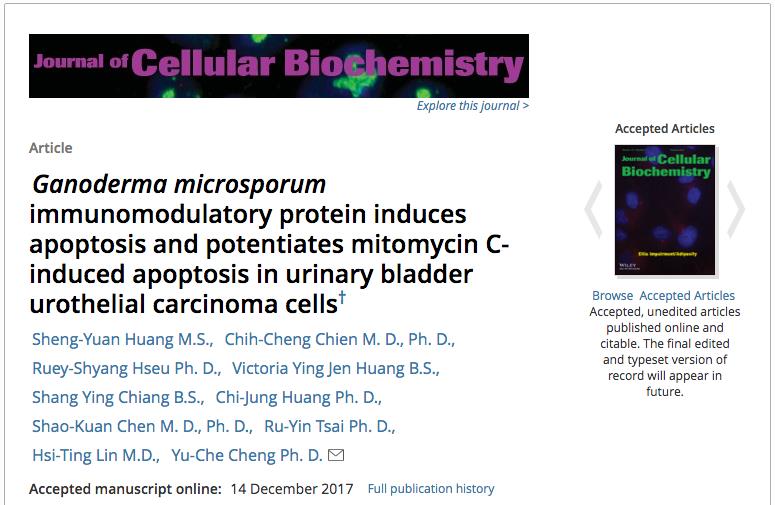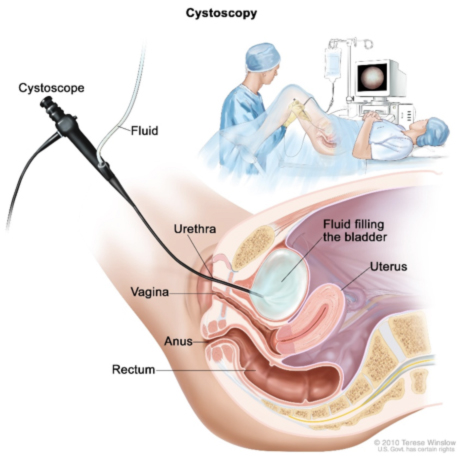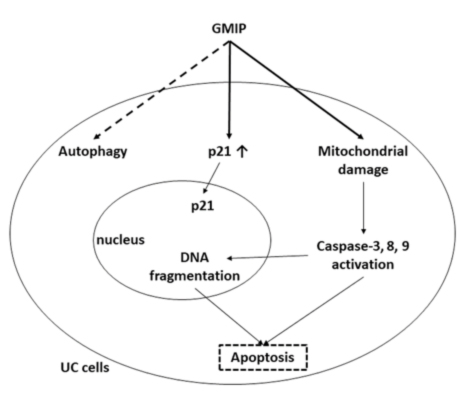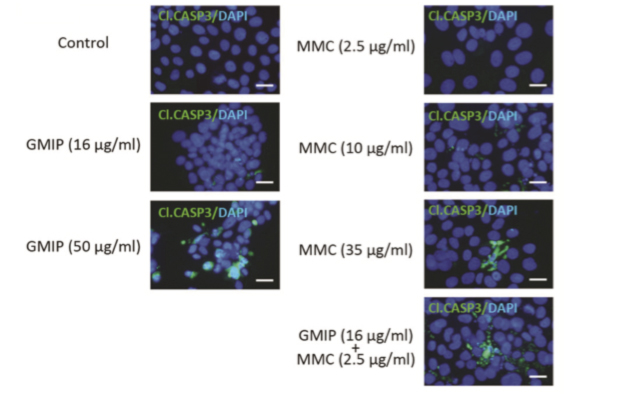在本篇论文中,研究者证明了小孢子灵芝免疫调节蛋白质GMI(Ganoderma microsporum immunomodulatory protein)可以藉由直接引发细胞凋亡机制,进而抑制及毒杀膀胱癌细胞的生长,并且可以有效降低传统化疗药物丝裂霉素的使用剂量并达到相同功效。此研究成果已於2017年12月线上发表在《Journal of Cellular Biochemistry》(纸本正式出刊日期为2018年6月)。研究者期待能够运用灵芝蛋白或相关产物,改善膀胱癌现行疗法的高复发率及副作用。
文.图/黄圣元

现行治疗最大宗之非肌层浸润性膀胱癌(Non Muscle Invasive Bladder Cancer, NMIBC)通常在内视镜(cytoscopy)移除病灶癌细胞後,采取化学药物如丝裂霉素(mitomycin C)或免疫药物如结核菌(Bacillus Calmette-Guérin)的尿道灌流[1]。
尽管现行疗法已经在医界广泛被使用,化学药物治疗通常无法根治膀胱癌,而且有很高的复发率;相对的,免疫疗法虽然效果较佳,却可能造成局部或全身的不良过敏反应[2 - 4]。

图1 经内视镜移除移除肿瘤细胞。经手术移除癌细胞病灶後,通常使用化学药物或免疫药物灌流治疗[1]。
先前中山大学柯俊良教授研究团队对於「小孢子灵芝免疫调节蛋白质GMI调控肺癌细胞自噬的死亡机制」已经有深入的探讨[5 - 8],不过在本篇研究中,研究者发现对非肌层浸润性膀胱癌处理後,除了有生长抑制的现象发生外,还发现其具有自凋亡的特徵,例如染色体聚缩(chromosome condensation),细胞膜皱褶(membrane blebbing)和凋亡小体(apoptotic body)形成 [9]。
经流式细胞仪分析,证明凋亡小体所携带的,是自凋亡後产生的DNA碎片。後续的路径探讨也发现,GMI可以直接藉由引发粒线体电位失衡而造成胱天蛋白酶(caspase activation)的截切活化及二磷酸腺苷核糖聚合酶(PARP)蛋白质的截切失活。
上述两蛋白质的表现分析为典型的细胞自凋亡讯号。而与之前研究不同的是,广效型胱天蛋白酶的抑制剂(Z-VAD-FMK)可以挽救GMI的毒杀能力;相对的,自凋抑制剂氯喹(chloroquine)则无法挽救其毒杀能力。此证据更加证明GMI可直接造成自凋亡之毒杀反应 [10]。

图2 灵芝蛋白GMI诱导膀胱癌细胞进入自凋亡之路径图 [10]
基於上述发现,本文作者也运用GMI以改善化疗药物丝裂霉素之疗效。研究发现,GMI可以有效降低丝裂霉素的十倍剂量已达相同功效。此外,运用免疫染色技术追踪胱天蛋白酶截切的大量表现及流式细胞仪追踪凋亡小体的增加,都足证运用GMI及丝裂霉素的协同机制为增强非肌层浸润性膀胱癌之自凋亡反应 [9]。

图3 免疫染色分析胱天蛋白酶截切(C.I. CASP 3),胱天蛋白酶截切为绿色萤光,细胞核为蓝色萤光。由图可见低剂量丝裂霉素(2.5 μg/mL)佐以灵芝蛋白GMI(16 μg/mL)可达到与高剂量丝裂霉素(33 μg/mL)之相同效果 [10]。
在本篇论文中,研究者证明了GMI可以藉由直接引发自凋亡机制,进而抑制及毒杀膀胱癌细胞的生长,并且可以有效降低传统化疗药物丝裂霉素的使用剂量并达到相同功效。
以上研究成果已於今年(2017)12月发表在《Journal of Cellular Biochemistry》。研究者期待能够运用GMI或相关产物,改善膀胱癌现行疗法的高复发率及副作用。
(本文作者黄圣元为台湾大学生化科技系许瑞祥教授指导的硕士班毕业学生,与国泰汐止研究中心蛋白质体学研究室郑宇哲博士合作完成此篇论文研究。)
引用文献
1. NIH, National Cancer Institute, Bladder Cancer Treatment (PDQ?)–Patient Version. Retrieved December 25, 2017, from https://www.cancer.gov/types/bladder/patient/bladder-treatment-pdq
2. Fernandez-Gomez J, Madero R, Solsona E, et al. Predicting nonmuscle invasive bladder cancer recurrence and progression in patients treated with bacillus Calmette-Guerin: the CUETO scoring model. J Urol. 2009;182:2195–2203. 5.
3. Brausi M, Oddens J, Sylvester R, et al. Side effects of Bacillus Calmette-Guerin (BCG) in the treatment of intermediate- and high-risk Ta, T1 papillary carcinoma of the bladder: results of the EORTC genito-urinary cancers group randomised phase 3 study comparing one-third dose with full dose and 1 year with 3 years of maintenance BCG. Eur Urol. 2014;65:69–76. 6.
4. Chou R, Selph S, Buckley DI, et al. Intravesical therapy for the treatment of nonmuscle invasive bladder cancer: a systematic review and meta-Analysis. J Urol. 2017;197:1189–1199.
5. Hsin IL et al. GMI, an immunomodulatory protein from Ganoderma microsporum, induces autophagy in non-small cell lung cancer cells. Autophagy. 2011;7(8):873-82.
6. Hsin IL et al. Inhibition of lysosome degradation on autophagosome formation and responses to GMI, an immunomodulatory protein from Ganoderma microsporum. Br J Pharmacol. 2012;167(6):1287-300.
7. Hsin IL et al. GMI, an Immunomodulatory Protein from Ganoderma microsporum, Potentiates Cisplatin-Induced Apoptosis via Autophagy in Lung Cancer Cells. Mol Pharm. 2015 4;12(5):1534-43.
8. Chiu LY et al. Immunomodulatory Protein from Ganoderma microsporum Induces Pro-Death Autophagy through Akt-mTOR-p70S6K Pathway Inhibition in Multidrug Resistant Lung Cancer Cells. PLoS One. 2015 6;10(5).
9. 黄圣元, 小孢子灵芝免疫调节蛋白抑制泌尿上皮癌细胞生长及调控其细胞程序性死亡机制探讨。台湾大学生化科技研究所硕士论文,2017年。
10. Huang SY et al. Ganoderma microsporum immunomodulatory protein induces apoptosis and potentiates mitomycin C-induced apoptosis in urinary bladder urothelial carcinoma cells. J Cell Biochem. 2018 Jun; 119(6): 4592-4606. doi: 10.1002/jcb.26616. Epub 2018 Feb 27.


